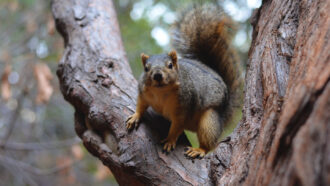
Parkour enthusiasts need look no further than up in the trees for inspiration. Squirrels’ aerial acrobatics make the rodents masters of the form, a new study suggests.
A detailed look at how squirrels navigate narrow branches that bend and sway with the wind — where the smallest error could spell death — shows that the rodents make split-second calculations to balance trade-offs between branch bendiness and the distance between tree limbs. And for particularly tricky jumps, squirrels improvise parkour-style moves in midair to stick the landing, researchers report in the Aug. 6 Science.
This study is “a great example of how cool ‘normal’ animals can be in their biomechanics,” says Michelle Graham, a graduate student in biomechanics at Virginia Tech in Blacksburg who was not involved with the research. “We’ve all seen squirrels do crazy stuff in nature, but no one ever pays any attention to it.”
That is unless you’re like Nathaniel Hunt, who has been mesmerized by watching squirrels flash through the overstory since graduate school. “Tree canopies are incredibly challenging environments to navigate,” says Hunt, an integrative biologist at the University of Nebraska Omaha. When jumping between bendy branches, a squirrel must assess how far it has to jump and know when to leap. Jump too early and the squirrel will fall short. Too late, and the squirrel will find itself on a branch too flimsy from which to launch. Hunt wondered, “How are they sensitive to that trade-off, managing to make accurate leaps?”
To find out, he and his colleagues designed an artificial forest obstacle course on the outskirts of the University of California, Berkeley campus. Then, the team used peanuts to coax free-ranging fox squirrels (Sciurus niger) into running and jumping through a series of acrobatic tests (SN: 1/29/19).
First, the unwitting subjects learned to leap from artificial branches of high, medium or low stiffness across a gap to reach a prize: a basket of peanuts at the end of a landing peg. High-speed video captured details of the jumps, from launch point to landing accuracy, for twelve squirrels spanning 96 leaping trials.
Unsurprisingly, the squirrels leaped from more bendy branches earlier — presumably to maximize jumping force — even though that increased the distance that the animals must clear, Hunt says. By comparing what the squirrels actually did with statistical models that simulated optimal jumping decisions, the researchers found something interesting: Branch flexibility had about six times as great an influence on when squirrels decided to jump as did the length of the gap. If squirrels had cared more about distance, they’d have jumped from about the same spot on the rod, regardless of its give. “We were surprised to see squirrels weighing both of these things simultaneously, but in different amounts,” Hunt says.
The researchers upped the ante for five squirrels by increasing the flexibility of branches as well as gap distance. Initial leaps were less than graceful. No squirrels fell, but most landed clunkily at first, grasping the peg they leaped to with their front paws and swinging around to pull themselves up instead of landing neatly on all fours. But within five trials, “squirrels learned to compensate for their initial error,” Hunt says, which they did by modifying their initial velocity.
If squirrels regularly encounter the same branches, such quick learning “might explain how they move so fluidly and rapidly” across particular branches, Hunt explains. The rodents might be such quick navigators, he says, because “they’ve already learned what they need to know about that branch.”
The squirrels surprised the researchers in other ways too. For longer jumps, or those that necessitated landing higher or lower than the starting point, many squirrels rotated midair, using their legs to “jump” off an adjacent vertical wall in a parkour-style maneuver. More often than not, squirrels employed parkour to slow down if they were coming in too hot to a landing. “It’s an additional point of control,” Hunt says.
For many arboreal animals, “jumping between limbs is such a common thing, and yet we so frequently only study it in pieces,” Graham says, such as looking just at the launch but not the landing. This study’s holistic look reveals “something really interesting about squirrels, that they take greater account of [branch bendiness] than the gap distance,” she notes. “I don’t know that I would’ve guessed that.”


